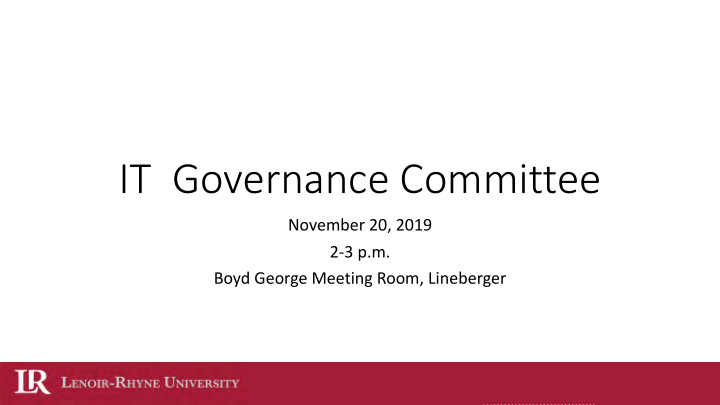



IT Governance Committee November 20, 2019 2-3 p.m. Boyd George Meeting Room, Lineberger
Website Assessment & Redesign Project External Website & Internal Portal—Doug Minor, associate vice president of digital strategy
Website Background • Launched in August 2016. • CMS used primarily by K-12 schools. • Five-year contract through 2021. • Website management is centralized in marcom office.
Website Assessment • Brand messaging and design – no clear brand messaging that sets LR apart from competitors. Site design and typography is poor, site photography is often repeated, cliché or posed photography, limited use of video across the site. • Poor user experience / site usability – inconsistent navigation, inconsistent header styles, content hidden inside accordions and tabs, overuse of buttons, content often opens in pop-up windows, no content prioritization/editing, missing clear calls to action. • Accessibility and web standards compliance – does not meet federal accessibility requirements.
Website Assessment • SEO issues – not all content is findable by search engines, e.g., directory information, faculty pages, calendar content. • Academic pages – majors/programs page is difficult to use. Site is missing minor information. Academic pages are text heavy, no photography or video, no faculty pages, missing important content about the student experience and outcomes, e.g., testimonials, internships, study abroad, student-faculty research/scholarship, student organizations, civic engagement, etc. • Audiences – Asheville, Columbia, and LTSS campus content is limited and poor user experience. Visitors to these sections are often pushed back to main site.
Path Forward • Website review and needs assessment • Focus groups and community input sessions – January 2020 • RFP – detail our needs, priorities and strategy. • Vendor/partner selection – redesign, ongoing maintenance, support and development. • Technology review and selection – alignment of technology to support our priorities, strategy, and grow with us. • Transparent process – updates shared regularly through redesign blog. • Study feasibility of considering web and intranet projects/needs together • Project timeline - 9-12 months
Web Redesign Priorities • User experience and site usability • Content strategy • Strong design aesthetic • Web standards and accessibility compliance • Responsive design • Search engine optimization (SEO) • Flexible, modular design; content syndication, content sharing. • Content personalization
MyLR Portal • Launched in fall 2016. • Microsoft SharePoint • Content updates primarily done by IT staff.
Portal Assessment • No clear strategy – what should our intranet/portal support? • Design and user experience – inconsistent design. Issues with content organization, content quality, etc. • No news, announcements or events integration – lost opportunity to push people to a central site for campus announcements, events, etc. • Unclear site audiences – student and employee information is intermixed. • Hickory-centric – Columbia campus is buried under the academics section. LTSS and Asheville don’t have a presence. • Not all offices/departments have a portal presence • What content should be on public vs internal site?
Path Forward • Intranet portal review and needs assessment • Gather community input – January 2020 focus groups & input sessions • Detail portal purpose, strategy and priorities • Consider public website redesign project and intranet project together, focus training and support across a single platform • Use best tool for job – employee/student communication, content management, collaboration, document management/sharing.
Path Forward – Digital Footprint • Focus on storytelling across platforms • Fully leverage an integrated marketing and communications strategy – web, email, video, social media, digital ads, paid content, email, text messaging, earned media. • Implement a robust content strategy , including social media, that is in alignment with new LR brand messaging. • Use organic, paid digital and social to expand our reach using new strategies and tactics—geofencing, IP targeting, behavioral advertising, retargeting, etc. • Third-party validation through earned media
Questions & Discussion
Recommend
More recommend